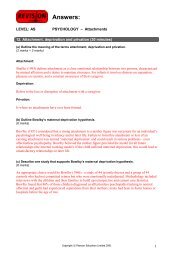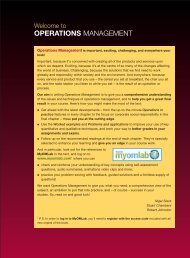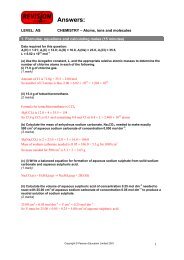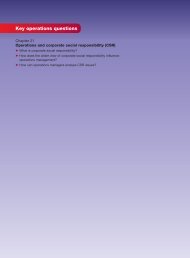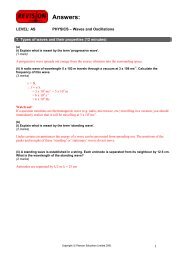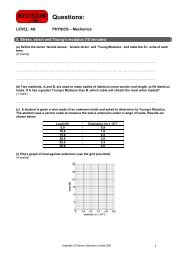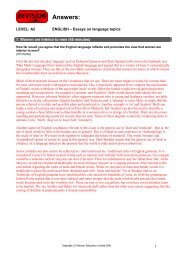Oxidation of alcohols, hydrolysis of halogenoalkanes and ... - Pearson
Oxidation of alcohols, hydrolysis of halogenoalkanes and ... - Pearson
Oxidation of alcohols, hydrolysis of halogenoalkanes and ... - Pearson
You also want an ePaper? Increase the reach of your titles
YUMPU automatically turns print PDFs into web optimized ePapers that Google loves.
Answers:<br />
LEVEL: AS<br />
CHEMISTRY – Organic chemistry<br />
11. <strong>Oxidation</strong> <strong>of</strong> <strong>alcohols</strong>, <strong>hydrolysis</strong> <strong>of</strong> <strong>halogenoalkanes</strong> <strong>and</strong> classification <strong>of</strong><br />
reacting species (15 minutes)<br />
(a) Potassium dichromate(VI) in aqueous sulphuric acid oxidizes propan-1-ol to two different<br />
products depending upon the reaction conditions. Draw the full structural formula <strong>of</strong> each<br />
product <strong>and</strong> state the reaction conditions required.<br />
Product 1:<br />
(1 mark)<br />
Structural formula:<br />
Conditions:<br />
Distil <strong>of</strong>f product as it forms.<br />
Product 2:<br />
(1 mark)<br />
Structural formula:<br />
Conditions:<br />
Reflux mixture to complete oxidation.<br />
(b) Give the systematic name <strong>and</strong> structural formula <strong>of</strong> the alcohol that potassium<br />
dichromate(VI) in aqueous sulphuric acid would oxidize to propanone.<br />
Systematic name <strong>of</strong> the alcohol: propan-2-ol<br />
(1 mark)<br />
Structural formula: CH 3 CH(OH)CH 3<br />
(1 mark)<br />
Copyright © <strong>Pearson</strong> Education Limited 2001 1
Answers:<br />
LEVEL: AS<br />
CHEMISTRY – Organic chemistry<br />
(c) 1-iodobutane <strong>and</strong> 1-chlorobutane both form butan-1-ol upon <strong>hydrolysis</strong>.<br />
(i) State the name <strong>of</strong> the reagent you would use to carry out the <strong>hydrolysis</strong>.<br />
(1 mark)<br />
Aqueous sodium hydroxide<br />
(ii) Explain, in terms <strong>of</strong> bond energies, why the iodo- compound hydrolyses more readily than<br />
the chloro- compound.<br />
(1 mark)<br />
The C–I bond is longer <strong>and</strong> weaker than the C–Cl bond <strong>and</strong> therefore more easily broken.<br />
(d) (i) Explain the meaning <strong>of</strong> the following terms.<br />
Nucleophile:<br />
(1 mark)<br />
A molecule or an ion that has an atom capable <strong>of</strong> donating a pair <strong>of</strong> electrons to form a dative covalent<br />
bond with an atom in an electrophile.<br />
Free radical:<br />
(1 mark)<br />
A short-lived atom or group <strong>of</strong> atoms having an unpaired valence electron.<br />
(ii) Put a tick () in the appropriate box <strong>of</strong> the following table to classify each <strong>of</strong> the species as<br />
nucleophile, electrophile or free radical.<br />
(3 marks)<br />
species nucleophile electrophile free radical<br />
Cl +<br />
<br />
·CH 3<br />
<br />
OH –<br />
<br />
Copyright © <strong>Pearson</strong> Education Limited 2001 2
Answers:<br />
LEVEL: AS<br />
CHEMISTRY – Organic chemistry<br />
(e) Athletes are banned from using the steroid, 19-nortestosterone, C 18 H 26 O 2 , an illegal drug<br />
known as n<strong>and</strong>rolone, whose structure can be written as:<br />
(i) Name <strong>and</strong> give the formula for the functional groups in the molecule that contain oxygen.<br />
(2 marks)<br />
functional group 1 functional group 2<br />
name: hydroxyl or alcohol carbonyl<br />
formula: –O–H >C=O<br />
(ii) Explain why n<strong>and</strong>rolone would be expected to react with bromine.<br />
(2 marks)<br />
Bromine would undergo an addition reaction with the C=C double bond or a substitution reaction with<br />
the CH 3 methyl group.<br />
(Total marks 15)<br />
ANSWERS<br />
Copyright © <strong>Pearson</strong> Education Limited 2001 3




